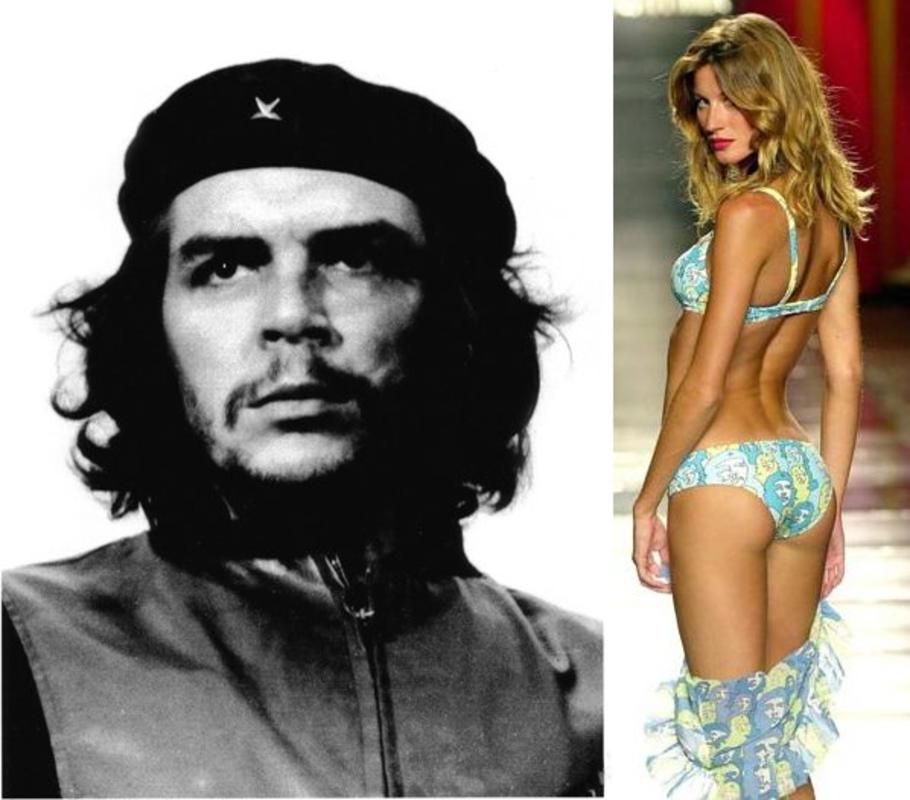
CHIC CHE: Even high-priced supermodel Gisele Bundchen has Marxist’s image on her bikini.
read more: Boston Herald
His face is everywhere. Che Guevara’s likeness is tattooed on boxer Mike Tyson’s chest and on soccer star Diego Maradona’s arm. Actor Johnny Depp wears a pendant of Che around his neck, and Gisele Bundchen, aka Mrs. Tom Brady, famously modeled a bikini bearing his image.
But it’s not just the glitterati who drape themselves in radical chic. Stroll the streets of Cambridge or Oak Bluffs, and you will see Che’s smoldering eyes staring out from the T-shirts of middle-aged tourists and young, bohemian-wannabes.
It is no surprise, then, that TIME magazine recently named Che one of the world’s “Top 25 political icons.” Indeed, the only curiosity is why TIME ranked him ninth — after all, if popularity on dorm-room posters and T-shirts is the measure, Che must rank in the top three, alongside Ronald Reagan and Barack Obama.
But do those who cloak themselves in Che really know the man?
Ernesto “Che” Guevara was a wealthy Argentine doctor who shunned his bourgeois upbringing to become a Marxist revolutionary. To the left, he represents the intellectual-warrior-liberator. But George Washington he was not.
As a young man, Che met Fidel Castro in Mexico, accompanied him to Cuba and became Castro’s military second-in-command. After Castro’s communists took power in Cuba, Che helped consolidate the revolution and move it firmly into the Soviet orbit.
As commander of the La Cabaña execution yard, he oversaw the use of firing squads to purge dissidents, religious believers and homosexuals, whom he deemed a threat to his idea of a socialist utopia. Che was, in his own words, “bloodthirsty.” And he enjoyed personally pulling the trigger whenever possible.
When he wasn’t busy dispensing “revolutionary justice,” Che found time to pen a manual on guerrilla tactics. This little gem of a book has, in recent years, earned him the nickname the “godfather of modern terrorism.”
When Che finished his work for Castro, he left Cuba to foment violent revolutions in Africa and Latin America. In 1967, Bolivian forces captured and executed Che, who was assisting guerrilla rebels against that country’s government.
So, back to TIME’s selection of Che as political icon: To be fair, TIME’s Top 25 is a list not of heroes, but of political leaders (the good, the bad and the ugly) who changed the world and whose legacies endure.
The list thus includes Mahatma Gandhi as well as Adolf Hitler. But in writing about these men, TIME speaks with moral clarity — Gandhi is “the spiritual heart of Indian independence” and Hitler “a universal symbol for evil.” When it comes to Che, TIME descends into murky relativism.
TIME praises Che as a selfless martyr, “the embodiment of a man true to his word,” and only begrudgingly concedes that by “modern definitions” Che would be “judged a war criminal.”
Modern definitions? Che practiced his murderous political philosophy in the 1950s and 1960s — not the 1550s! Has the definition of “war criminal” changed that much in half a century? No. By the standards of both his own time and ours, Che was a war criminal — a “bloodthirsty” murderer and totalitarian who oppressed his own people and advocated the use of terrorism against the United States.
It is time to abandon silly notions of moral equivalency. Not all revolutions increase freedom, and not all revolutionaries are liberators. TIME Magazine, Gisele and other promoters of radical chic should be called to task for celebrating tyrannical revolutionaries like Che. And the next time you see someone wearing a T-shirt with Che’s face, look him in the eye and ask, “Osama Bin Laden T-shirt in the wash?”
